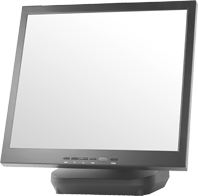Unlike a television screen, touch screens don’t come in too many different types (LCD, Plasma etc). Instead, they are generally considered to be resistive or capacitive depending on how they react when pressure is applied to them – that’s basically the only difference that affects usability but there are a lot of considerations when you come to choosing the right model for your business:
Screen Size and Resolution
It is very unlikely that your business will need a 50” HD touchscreen to be used for your kiosk – possible but unlikely – meaning you’d be better suited to a smaller option. Thankfully, smaller screens are generally more durable and display images more clearly. If you do need a larger option, they are available but can become more expensive owing to the number of pixels required to recreate images on a larger scale.
Aspect Ratio
In brief, this refers to the screen’s ratio of its width to height. Televisions were traditionally designed with a ratio of 4:3 until the advent of widescreen changed this to 16:9. True widescreen can now be achieved on touch screens using the ratios: 1024 x 576, 1152 x 648, 1280 x 720, 1600 x 900 and 1920 x 1080 pixels.

Brightness and Contrast
Basically, you will want your touchscreen to be capable of producing the deepest black and brightest white possible to achieve perfect luminescence. Digital signage is generally designed to be 10% brighter than any other screens on the market but it is unnecessary when dealing with smaller touchscreens; as long as it can be seen clearly at close range it is fine – don’t spend additional sums for something you don’t need and will no doubt reduce to normal levels.
Inputs
Almost everything is handled via HDMI these days but VGA and DVI still have a part to play –the general recommendation is that more input options is better than limiting the functionality.
Output
Essential output: phono jacks for headphones and speakers. These won’t only be useful to the hard of hearing; many of your users will want to hear the audio should any be available.
Chassis
Also known as the screen’s mounting, the most popular options are either freestanding or wall mount akin to most televisions or some form of rack mounting. These aren’t the only options but some businesses find that they are most cost effective and most familiar for installation and maintenance. If you get in touch and explain your requirements we will advise you on the best chassis to use.
Multiple Monitor Drive
If you have several screens in close proximity and want them to show identical information, you can invest in distribution boxes to effectively split the signal and allow multiple users to access your screens – ensure they are capable of handling separate information before spending on them; they can be very inflexible at the cheaper end.
Screen Tech
The user doesn’t actually need to come into contact with your screen if you use thru-glass projection tech. It can be costly, but it reduces maintenance costs simply by not affording users the chance to break the screen.